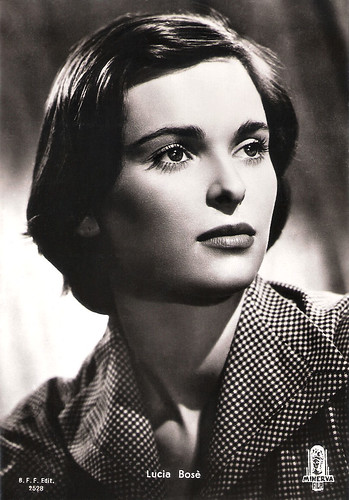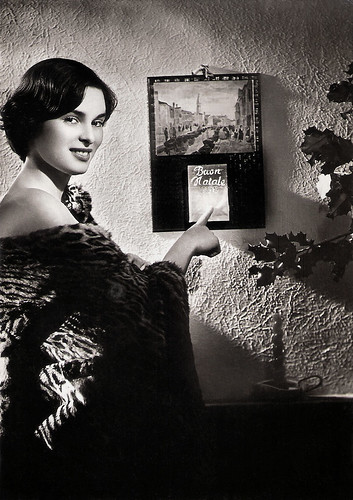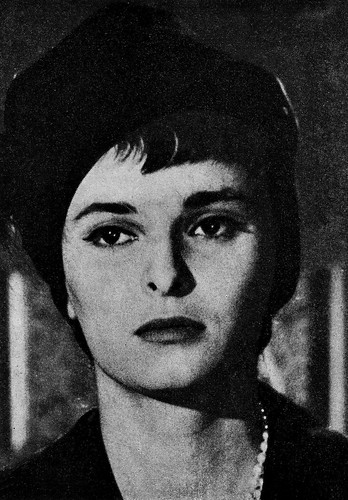
Italian postcard by Bromofoto, Milano, no. 270.

Italian postcard in the series 'Divi del Cinema' by Vetta Traldi, Milano, no. 7.

Italian postcard by Ballerini & Fratini Editori, Firenze, no. 2528. Photo: Minerva Film.
Miss Italy
Lucia Bosè was born Lucia Borloni in Milan, Italy in 1931. She came from a peasant and working-class family and began to work at the age of twelve years. First, she was a messenger for a law firm, later a clerk in Milan's fine pastry shop Galli.
In 1947 she participated in the first Miss Italy pageant, where she was able to win against competitors like Gianna Maria Canale, Eleonora Rossi Drago, and Gina Lollobrigida.
Giuseppe De Santis had preferred Silvana Mangano for Riso amaro/Bitter Rice (1949), but he chose Bosè for his next film, Non c'è pace tra gli ulivi/No peace among the olive trees (Giuseppe De Santis, 1950), a typical Neorealist film about a poor shepherd (Raf Vallone) who tries steal back his sheep stolen from him while he was at war.
In the same year, Bosé starred opposite Massimo Girotti in the well-to-do set, modernist crime story and drama Cronaca di un amore/Story of a love affair (Michelangelo Antonioni, 1950). It was Antonioni's first full-length feature film, about an adulterous couple plotting to kill her husband.
Numerous screen engagements followed. Antonioni cast her again in La signora senza camelie/The Lady Without Camelias (Michelangelo Antonioni, 1953) about a newly discovered starlet and her experiences in the Italian cinema. Juan Bardem cast her in Muerte di un ciclista/Death of a Cyclist (1955) about an adulterous couple that runs over a cyclist and leaves him to die. Bosé also acted in Francesco Maselli's debut Gli sbandati/The Abandoned (1955) and Luis Buñuel's Cela s'appelle l'aurore/That is the Dawn (1956).

Italian postcard by Rotalfoto, Milano, no. 295.

Italian postcard by Italfoto, no. 162.
Bullfighter
In 1955, Lucia Bosè married Luis Miguel Dominguín, a popular Spanish bullfighter and occasional actor. From the marriage, which ended in divorce in 1967, sprang three children, two of whom - Paola Dominguin and Miguel Bosè - are also active as actors. Luchino Visconti was godfather to her son Miguel, Pablo Picasso to her daughter Paola.
At the time, Lucia Bosè lived in Spain and put her career on halt, except for a sporadic appearance in Le testament d'Orphée/Testament of Orpheus (Jean Cocteau, 1959). In 1968, Bosé returned to film acting after almost a ten-year break and worked first in Spain and afterwards in Italy. There she worked among others in Federico Fellini's Satyricon (1969), the Taviani Brothers' Sotto il segno dello scorpione/Under the Sign of Scorpio (1969), and Liliana Cavani's L'ospite/The Guest (1972).
Other interesting films with her were Nathalie Granger (Marguerite Duras, 1972), Lumière (Jeanne Moreau, 1976), and Violanta (Daniel Schmid, 1977).
After 1978, she acted significantly less but remained active, also on television. She had memorable film performances in Cronaca di una morte annunciata/Chronicle of a Death Foretold (Francesco Rosi, 1987) starring Rupert Everett, El niño de la Luna/Moon Child (Agustí Villaronga, 1989), Harem suaré/Harem (Ferzan Özpetek, 1999) and I vicerè/The Viceroy (Roberto Faenza, 2007).
Her last screen appearance was in Alfonsina y el mar/One more time (Pablo Benedetti, David Sordella, 2013), as an 80-year-old actress who returns to the small Chilean town of her youth to fulfil her father's dream of creating a TV channel in a place which has never known television.

Italian postcard by Italfoto, Terni. Photo: Vedeo.

Spanish collectors card by Tarjetas Florita, no. 102. The cards were included in the magazine Revista Florita.

French postcard TTG / ADAGP, Paris, 2013, no. 0183000053. Photo: Lucien Clergue. Luis Miguel Dominguin, Jacqueline and Pablo Picasso, Jean Cocteau, Lucia Bosé and Serge Lifar.
Sources: Wikipedia (German, English, and Italian) and IMDb.
This post was last updated on 16 July 2023.
1 comment:
She beat out Gina in a beauty contest? Now that's really an achievement!
Post a Comment